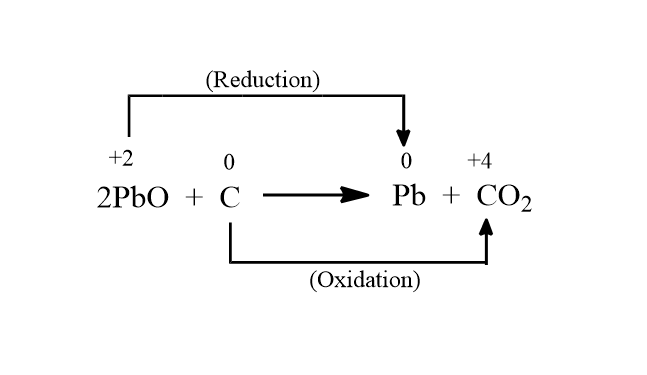Question
Question: For the given reaction, \[2PbO + C \to Pb + C{O_2}\] name the oxidized substance, reduced substanc...
For the given reaction,
2PbO+C→Pb+CO2 name the oxidized substance, reduced substance, reducing agent, and oxidizing agent in this reaction.
Solution
For finding the oxidized substance, reduced substance, reducing agent and oxidizing agent in the above reaction first calculate the oxidation states of lead and carbon in the reaction. Observe the change in the oxidation states of lead and carbon in both the reactant side and the product side.
Complete answer:
The above reaction is a redox reaction. We have to find out the oxidized substance, reduced substance, reducing agent, and oxidizing agent in this reaction. For this let us see how the oxidation states of the compounds change during the reaction.
The reaction given is:
2Pb+2O−2+C0→Pb0+C+4O2−2
So we can see in the above reaction that there is change in the oxidation state of lead from +2 to 0 and carbon changes from 0 to +4. The oxidation and reduction is taking place in the following manner.

As we can see in the above image Lead oxide is undergoing reduction and changing to lead whereas carbon is undergoing oxidation and changing to carbon dioxide. So by this, we can say that lead is a reduced substance, carbon dioxide is an oxidized substance. Thus lead oxide acts as an oxidizing agent as it is oxidizing carbon to carbon dioxide and itself it is getting reduced. And carbon acts as a reducing agent because it is reducing the lead oxide to lead and it is getting oxidized.
Note:
The above reaction is a thermodynamic reaction taking place in a blast furnace. The reaction takes place at a high temperature of 1000C. This is an exothermic reaction. Once the reaction starts, the temperature is 1000C, but as the reaction continues the temperature of the furnace soon rises to about 12000C and the reduction of lead oxide takes place. And for this reaction, Gibbs free energy value is also negative.
